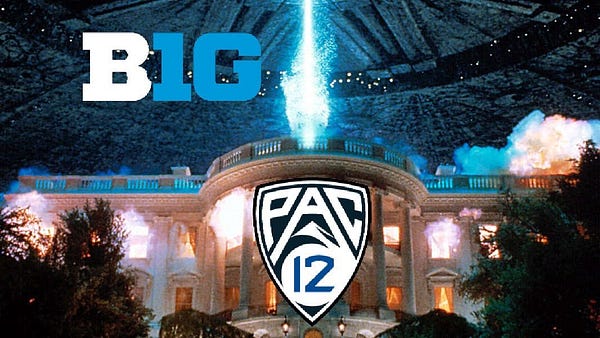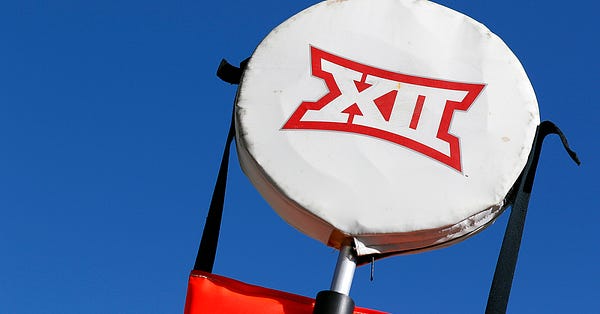Where do Cal and the remaining Pac-12 schools stack up in realignment to the Big Ten & Big 12?
A lot of moving pieces hinge on Notre Dame's next move, let's take stock.
TUESDAY UPDATE: The Big 12 is looking at as many as six teams now. Arizona, Arizona State, Colorado and Utah have already been reported. My guess is Oregon and Washington are the other two, if the Big Ten decides not to take them at this time.
Obviously, this week is going to be a crucial inflection point for the future of the Pac-12 programs.
The Pac-12 itself is doomed as a Power 5 conference at the very least, potentially as a conference altogether. Estimates of the revenue loss from losing the Los Angeles market estimate out to about 40%.
That will drop the remnants of the conference to mid-major status well behind the Big 12 and ACC. There is no acquisition of Mountain West programs possible that will offset the losses of the Los Angeles programs—San Diego State and UNLV might provide a temporary band-aid, but there aren’t any other Mountain West markets that give the Pac any sort of proportionate revenue split. The Pac-12 lacks the soft power necessary to entice other major schools to join from elsewhere in the college football landscape.
So what course do the remaining schools set? As we know, several schools from what remains of the Pac-12 South are already in early discussions with the Big 12. But what comes next for who’s left?
Let’s take a look at each of them and the pros and cons for inclusions in the consolidating college football power race:
Oregon
Pros: Easily the Pac-12's most modern national brand, Oregon has been the most competitive program in the last decade-plus, making the national title game twice, winning the conference half the decade, and building an exciting brand that attracts national attention. It’s by far the most popular school on the West Coast because of its partnership with Phil Knight and Nike. It outranks both USC and UCLA at this moment as a competitive college football matchup—Oregon vs. Ohio State was the 11th highest rated game in 2021. Oregon is also an AAU research institution and would give the Big Ten inroads into the Pacific Northwest.
Cons: Eugene and even Portland is a bit of a smaller market, so even with all the branding in its favor, the financial benefit isn’t quite as apparent as it was for hauling in Los Angeles. USC/UCLA also doesn’t seem to want them at the outset because Oregon has built inroads into Los Angeles from a recruiting perspective.
Conclusions: Regardless, this should all still be enough for the Big Ten to extend an invite to Oregon in the near future. They’re too competitive to be turned down, too big from a national perspective to be let go.
If they say no though, expect all the other major conferences to come calling with offers. The Big Ten has to treat this like free agency—there are plenty of suitors at the door.
Washington
Pros: Washington’s brand isn’t quite as strong at the moment, but it has all the makings of a sleeping giant. The Huskies are the second most successful football program in Pac-12 history, and the only other Pac-10 program besides USC to win a national title in the last four decades. Washington has the best academic brand of any of the non-California schools in the conference. Seattle is the fourth largest market in our footprint. It enjoys a very competitive donor base.
Cons: Aside from the amazing success of the Chris Petersen era, Washington has struggled a bit with consistency in the BCS/Playoff period. Their bargaining position isn’t quite as strong as it would’ve been a few decades ago, or even a few years ago. It’s safe to say that there is a lot of potential but it might take some time to realize it.
Conclusions: Like Oregon, Washington is too big to be kept out of a major conference. There is the North Star of the B1G, but the Big 12 will happily scoop them up if denied this round. But they are probably a slight peg behind Oregon.
It feels like Oregon and Washington should be a package deal, but it’s not an inevitability.
Stanford
Pros: The most marketable national academic brand, Stanford is by far the school equated with general prestige around the country, for worse or for worst. It fits the academic and research profile of the B1G, plus it placates USC/UCLA with a rival to play. More importantly, Notre Dame wants a trip to California every year for recruiting purposes, and also to check out the Bay Area and their Jesuit/Catholic pipeline and Stanford provides them with that opportunity.
Cons: Stanford has barely any fans. Stanford games are a dead zone of opposing alum maneuvering their way into Palo Alto. Therefore Stanford isn’t exactly the biggest lift from a TV perspective. Still, Stanford is in the Bay Area and the Bay Area media covers Stanford plenty, so you’d have to guess they’ll try.
Conclusions: Stanford has a ton of options. With the largest university endowment and a significant academic endowment, the Cardinal do not have to feel beholden to any one conference. While the B1G might be enticing, it could be equally enticing for Stanford to go their own ways and set their own terms as an independent.
And it remains to be seen how they feel about their longstanding relationship with Cal, one of the last true old-standing rivalries remaining in college football. They are a true wild card.
Cal
Pros: Similar to Stanford, except they do have a larger fanbase. So the TV and ticket sale numbers that don’t apply to Stanford should apply to Cal. The Bears consistently draw more eyeballs and tickets over even the best Stanford teams. But Cal definitely has more interest from Bay Area fans if they were to return to national TV and not be saddled by Pac-12 incompetence.
Cons: The Cal fanbase prone to hibernating during lean times, and Cal is in lean times. The administration is a bit all over the place, and has had trouble gathering consensus behind revenue sports. Despite being a large sports market, the Bay Area has a lot of successful professional sports. Cal is probably low on the totem and might not attract as high a market.
Conclusions: Other dominoes will have to fall, but the Bears can’t afford to sit on the sidelines. Cal has debts to pay. They need to be in a major conference or risk AD implosion. There is a lot of political wrangling the Bears should attempt before throwing in the towel. The Big Ten must be prioritized.
However, it does seem like they are lower on the pecking order—other programs will need to be invited first, and it’s quite possible someone else will need to stand up for the Bears. Just remember Cal’s hand is stronger than we think. The Bay Area eyeballs loom large.
Utah
Pros: Aside from Oregon, they are by far the most committed program in the Pac-12 to winning, and one of the best run athletic departments in the country. Their fans are loyal and dedicated. Utah has made prudent decisions to move up the ranks and seems to be set to survive in the changing landscape. The Utes have been the most consistent Pac-12 South program for much of the last decade and have a steady foundation to build on.
Cons: Unfortunately Utah is in a smaller market, making the financial case harder for the larger B1G. The Utes are the second biggest draw in town though behind the Jazz, so it might make up for that.
Conclusions: Utah will survive, and at this point will most likely end up in the Big 12 unless another conference comes pitching. But the Big Ten should really consider the Utes. They check off a lot of boxes—rising brand, solid athletics and academics, and would capture the best program in the Mountain Time Zone.
Arizona State
Pros: Arizona State holds the Phoenix market, third largest in the West, and are the largest public university in the conference. If you’re in on expansion into all major markets, Phoenix seems like it should be pretty high on the radar.
Cons: Their athletic department is a mess, their football program is facing major investigation, and they aren't a AAU research institution, which would be disqualifying for the Big Ten. The Sun Devils have a lot of fixing before they’d be ready for a leap to a major conference.
Conclusions: ASU is too big to fail, but their best fit for now is the Big 12. It makes sense that they’re reaching out that way this week.
Arizona
Pros: Arizona has the best basketball team history-wise in the Pac-12, and from an academic and research profile matches up with the Big Ten. The Wildcats have a good program.
Cons: Unfortunately for the Wildcats, basketball and academics is secondary in this current realignment discussion. Aside from one nice Fiesta Bowl run, Arizona football has been in the wilderness for most of its existence. Tucson is also a very small market. You could make a case Arizona alumni could capture the Phoenix market.
Conclusions: Arizona's hoops profile will keep them in the game somewhere, and it’s looking like the Big 12, which would work out pretty well—the Big 12 has some great basketball programs, including the last two national champions!
Colorado
Pros: Colorado is close to Denver and could potentially capture this market. They also match the academic and research profile.
Cons: The Buffs have not invested heavily in football and it shows. Colorado is also very secondary in the Denver market, which holds all four professional sports.
Conclusions: The Denver market will keep the Buffs afloat. Colorado's fate likely rides on joining a larger cohort of teams in their moves, which is looking like the Big 12.
Oregon State and Washington State.
Pros: The cases are very similar. Both Oregon State and Washington State are dedicated small schools that love and support their teams. They have earnest fanbases that are devoted. They have a century of tradition going back with Oregon and Washington that’s in danger of being lost.
Cons: Everything else is working against them. Corvallis and Pullman are the smallest markets in the conference. There’s a reason Oregon State and Washington State are resorting to political pressure to try and keep themselves tied to the hip with Oregon and Washington. It’s their best shot of a big conference invite.

Similar efforts took place with Oklahoma/Oklahoma State though, and Oklahoma eventually ended up in the SEC. It’d be hard to see these efforts as anything but a good PR line. If Oregon and Washington find homes that are justified by significantly higher financial lines, and Oregon State and Washington State aren’t invited, it’ll be hard for their to be legal state recourse that wouldn’t let them go. (UCLA did a similar thing to Cal last week and met little resistance from the UC Regents).
The Beavers and Cougars are likely going to have to find a new home and it's unlikely to be B1G. Who would take them feels very much like a mystery—perhaps they could latch onto the Big 12, because the alternatives get pretty dire.







Seems like a real chance OSU and Wazzu could end up in the Mountain West.
What a complete mess this all is.
Fantastic work, Avi. Greatly appreciated as well.